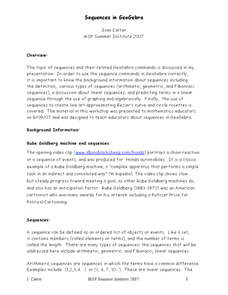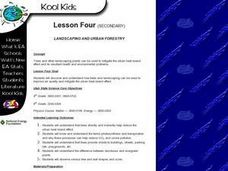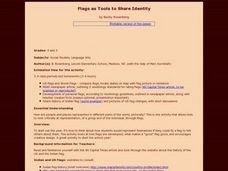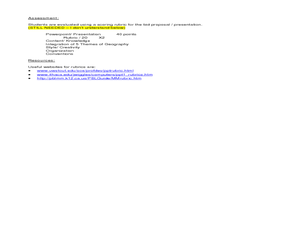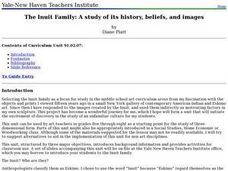Finding Background Information Teacher Resources
Find Finding Background Information lesson plans and worksheets
Showing 776 resources
Curated OER
Landscaping and Urban Forestry - Lesson 4 (Grades 5-6)
Students discuss reasons to plant trees and the best locations for cooling. They analyze two homes identifying types and locations of trees, and location of the central air conditioners. The benefits of shade, the process of...
Curated OER
Capturing the Reader With Vivid Images
Students examine how the author tries to capture the reader's imagination immediately, through imagery--and hold on to it. They locate Ukraine on a world map and understand Lenin's role in the establishment of Russian communism and the...
Curated OER
Inuit Lesson
Students investigate the Inuit People. In this Inuit lesson, students locate where they live on a map, outline their history and describe their lifestyle. Students play Inuit games, practice using the Inuit alphabet and examine the...
Curated OER
Sequences in Geogebra
Students follow detailed directions to use the GeoGebra program. In this mathematics instructional activity, students find the nth term of a sequence, and use line art to approximate a Bezier's curve. Students locate points and segments...
Curated OER
Sunspots
Young scholars examine what a sunspot is and how it is produced. In this sun lesson students locate and measure sunspots then view them through a camera.
Curated OER
Landscaping And Urban Forestry - Lesson 4 (Grades 8-9)
Students discuss reasons to plant trees and the best locations for cooling. They study two homes and identify types and locations of trees and determine the placement of the central air conditioners. The class plans a landscape design...
Curated OER
Flags as Tools to Share Identity
Young scholars compare flags, locate states on map with flag picture or miniature. Read a newspaper article outlining five vexillology standards for rating flags. They develop a personal flag with an essay interpreting their flag to the...
Peace Corps
Cuisine and Etiquette
Students identify the main food in the different cultures they have examined. In groups, they compare and contrast their expected table manners to the ones in Sierra Leone, Uganda and Zambia. Using this list of behaviors, they identify...
Curated OER
Who's Up for the Olympic Challenge?:Integrating the 5 Themes of Geography with Olympic Bids
High schoolers explore geographical themes. In this problem solving geography lesson, students view a PowerPoint presentation about the Vancouver/Whistler Olympic bid. High schoolers analyze Vancouver as an Olympic site...
Curated OER
The Inuit Family: A study of its history, beliefs, and images
Students study the Inuit in terms of their geographic location and its influence on their way of life. They investigate Inuit imagery as a reflection of their belief system and focus on the objects of the Inuit to introduce...
Curated OER
Tracking Down Traits
Sixth graders list traits that all sixth graders share. They receive worksheets "Tracking Down Traits," working in groups to complete the chart. Students share results with the class and a class summary is tallied. Students discuss the...
Curated OER
Topographic Maps
In this topographic map worksheet, students learn how to read a topographic map and create a topographic map of their own using clay or Play-Doh. Students include contour lines by layering the clay. Students answer 6 questions about...
Curated OER
Twain: Steamboat's a-Comin'
Students discover how rivers inspire creative expression. In this Mark Twain instructional activity, students list songs about rivers and discuss common characteristics. They locate the Mississippi River on a map and write a script...
National Endowment for the Humanities
Lesson 1: In Depth with the Full Spectrum
High schoolers study the ways in which an artist can use color. They view various images of artwork and discuss the effect of color on spacial dimensions, focal points, tone, and mood.
Curated OER
The Path of Pollution
Learners conduct a brainstorming exercise that asks them to list all the ideas about air pollution that can be recalled. The ideas are recorded on a chart that the teacher has prepared. The instructional activity contains sufficient...
Curated OER
Lone Pine- Cultural Fire Management
Fourth graders investigate the concept of fire and how it was used by the Native Americans. The lesson has sufficient background information for the teacher to establish historical context. Students summarize the nine uses for fire to...
NOAA
Ground-truthing Satellite Imagery with Drifting Buoy Data
Ground-truthing ... is it even a word? The last installment of a five-part series analyzes how scientists collect sea surface temperature data. Scholars use government websites to compare temperature data collected directly from buoys...
Virginia Department of Education
Elements and Electron Configuration
It's electronic! Pupils uncover elements and their electron configurations as they explore mass, groupings, correct charges, and sliding theory. Young scientists learn creative ways to remember various elements and correctly...
Polar Trec
Nature's Density Column
Nature provides density columns in the polar regions that provides food for many animals. Young scientists build their own density columns with water in order to answer analysis questions. Through a slideshow presentation, scholars...
PBS
Who Knows Best
Finding an expert in a given field when conducting research can be a challenge. This guide provides step-by-step directions as well as links to resources that help young sleuths find the authorities and experts they need. As a bonus, two...
Rivanna Regional Stormwater Education Partnership
Invisible Passengers
How does water pollution affect the organisms living in the water? Use three science experiments to examine how erosion and other pollutants can affect water quality. Each experiment focuses on a different aspect of pollution and...
Curated OER
Korean War
Students visualize where the Korean Peninsula is located and what are some neighboring countries. They read a handout giving background information on Korea's 20th centuy history and Truman's Statement and answer questions in their...
Curated OER
A Cowboy's Life
Students observe a photograph of a cowboy and brainstorm things a cowboy would do. They reveiw text about Wyoming and locate facts and information about a cowboys life then create a friendly letter containg key components found in a...
Curated OER
Mapping the Homunculus
Students determine the relative number of nerve endings located in the skin. By calculating the reciprocal of these measurements, students have the appropriate data for predicting the relative size of the homunculus found on the cerebral...





